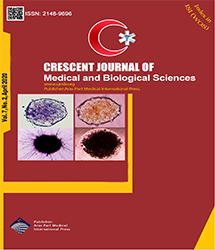
| Original Article | |
| Determinants of Postpartum Post-traumatic Stress Disorder: A Cross-Sectional Study | |
| Shekoofehsadat Mousavi1, Roghaiyeh Nourizadeh1, Fatemeh Mokhtari2, Sevil Hakimi1, Jalil Babapour3, Saeed Mousavi4 | |
| 1Department of Midwifery, Faculty of Nursing and Midwifery, Tabriz University of Medical Sciences, Tabriz, Iran 2Department of Midwifery, School of Medicine, Arak University of Medical Sciences, Arak, Iran 3Department of Psychology, University of Tabriz, Tabriz, Iran 4Department of Statistics and Epidemiology, Faculty of Health, Tabriz University of Medical Sciences, Tabriz,Iran |
|
|
CJMB 2020; 7: 254-259 Viewed : 6852 times Downloaded : 3187 times. Keywords : Post-traumatic stress disorder, Traumatic childbirth, Perceived support, Satisfaction with childbirth |
|
| Full Text(PDF) | Related Articles | |
| Abstract | |
Objectives: Postpartum post-traumatic stress disorder (PTSD) is regarded as a life-threatening childbirth experience for mother or infant and may be accompanied with the risk of death or serious injury to the mother or her infant. Given the changes to diagnostic criteria of traumatic childbirth brought in with DSM-5 and considering the unfavorable outcomes of postpartum PTSD, this study was carried out to identify the determinants of postpartum PTSD. Materials and Methods: This cross-sectional study was conducted in 2018 on 310 postpartum women who had experienced a traumatic childbirth, based on the DSM-5 criteria, and referred to Tabriz health centers for routine care 42-60 days after the delivery. Subjects were selected through convenience sampling. Research instruments were demographic, obstetric, and neonatal information questionnaire, Post-Traumatic Stress Checklist for DSM-5 Criteria (PCL-5), Mackey Childbirth Satisfaction Rating Scale, and Winefield and Tiggemann Social Support Questionnaire. The data were analyzed using SPSS version 25.0, and ANOVA, independent t-test, Pearson correlation coefficient test, Spearman correlation coefficient test, and multivariate linear regression were applied. Results: The mean score (±standard deviation) of postpartum PTSD was 42.13 (±11.72). The determinants of postpartum PTSD also included complications during pregnancy, type of delivery, concordance between desired and actual type of delivery, method of placenta removal, analgesia, sleeping and neonatal states, satisfaction with childbirth, and perceived support during and after childbirth. Conclusions: Designing interventions to make childbirth more pleasant through provision of methods for a pain-free or pain-reduced childbirth, promotion of satisfaction with childbirth, and support during and after the childbirth seem to be essential for reducing postpartum PTSD. |
Cite By, Google Scholar
Google Scholar
PubMed
Online Submission System
 CJMB ENDNOTE ® Style
CJMB ENDNOTE ® Style
 Tutorials
Tutorials
 Publication Charge
Medical and Biological Research Center
About Journal
Publication Charge
Medical and Biological Research Center
About Journal
Aras Part Medical International Press Editor-in-Chief
Arash Khaki
Deputy Editor
Zafer Akan


















